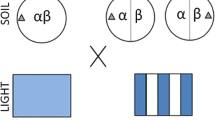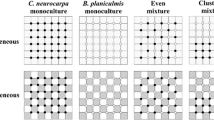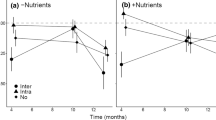Abstract
Size variability in plant populations has been extensively studied andmuch of this inquiry has focused on the types of competition that are involvedin increasing or decreasing size inequality. It is often assumed thatcompetition for light is size-asymmetric, meaning that a plant canpotentially dominate a competitive relationship through shading if it is tallerthan its competitor. The light resources obtained by the taller plant are thusdisproportionate to its size. In contrast, competition for soil resources maybemore size-symmetric, the amount of soil nutrients obtained seems to be indirect proportion to a plant's size. Most studies examining belowgroundcompetition have used homogeneouslydistributed nutrient resources. Soil homogeneity could makesize-asymmetric belowground competition unlikely, but homogeneity is notoften found in nature. In this study I use a greenhouse pot experimentutilizingIpomoea tricolor to examine the hypothesis thatsize-asymmetric competition for soil nutrients may result when soilresource distribution is spatially heterogeneous. The results did not supportthe hypothesis of belowgroundsize-asymmetric competition. Differences between experimental treatmentsand controls were not statistically significant suggesting size-symmetriccompetition. Implications of these results are discussed.
Similar content being viewed by others

References
Benjamine L. 1984. Role of foliage habit in the competition in the competition between differently sized plants in carrot crops. Annals of Botany 53: 549–557.
Casper B. and Cahill J. 1996. Limited effects of soil nutrient heterogeneity on populations of Abutilon theophrasti (Malvaceae). American Journal of Botany 83: 333–341.
Casper B. and Jackson R. 1997. Plant competition underground. Annual Review of Ecology and Systematics 28: 254–70.
Dixon P., Weiner J., Mitchell-Olds T. and Woodley R. 1987. Bootstrapping the Gini-Coefficient of inequality. Ecology 68: 1548–1551.
Einsmann J., Jones R., Pu M. and Mitchell R. 1999. Nutrient foraging traits in 10 co-occurring plant species of contrasting life forms. Journal of Ecology 87: 609–619.
Fitter A. and Strickland T. 1991. Architectural anaysis of plant root systems. 2. Influence of nutrient supply on architecture in contrasting plant species. New Phytologist 118: 383–389.
Hutchings M. and Wijesinghe D. 1997. Patchy habitats, division of labour and growth dividends in clonal plants. Trends in Ecology and Evolution 12: 390–394.
Jackson R. and Caldwell M. 1992. The scale of nutrient heterogeneity around individual plants and its quantification with geostatistics. Ecology 74: 612–614.
Newberry D. and Newman E. 1978. Competition between grassland plants of different sizes. Oecologia 33: 361–380.
Pregitzer K., Zak D., Curtis P., Kubiske M., Teeri J. and Vogel C. 1995. Atmospheric CO2, soil nitrogen and turnover of fine roots. New Phytol 129: 579–585.
Robinson D. 1994. The responses of plants to non-uniform supplies of nutrients. New Phytologist 127: 635–674.
Schwinning S. and Weiner J. 1998. Mechanisms determining the degree of size asymmetry in competition among plants. Oecologia 113: 447–455.
Silvertown J. and Lovett Doust J. 1993. Introduction to Plant Population Biology. Blackwell Scientific Publications, New York.
St. John T. 1983. Response of tree roots to decomposing organic matter in two lowland Amazonian rain forests. Canadian Journal of Forestry Research 13: 346–349.
Weiner J. 1986. How competition for light and nutrients affects size variability in Ipomoea tricolor populations. Ecology 67: 1425–1427.
Weiner J. 1988. Variation in the performance of individuals in plant populations. In: Davy A., Hutchings M. and Watkinson A. (eds), Plant Population Ecology: The 28th Symposium of the British Ecological Society. Blackwell, New york, pp. 59–81.
Weiner J. 1990. Asymmetric competition in plant populations. Trends in Ecology and Evolution 5: 360–364.
Weiner J. and Thomas C. 1986. Size variability and competition in plant monocultures. Oikos 47: 211–222.
Weiner J., Wright D. and Castro S. 1997. Symmetry of belowground competition between Kochia scoparia individuals. Oikos 79: 85–91.
Weiner J. and Solbrig O. 1984. The meaning and measurement of size hierarchies in plant populations. Oecologia 61: 334–336.
Wijesinghe D. and Hutchings M. 1997. The effects of spatial scale of environmental heterogeneity on the growth of clonal plant: an experimental study with Glechoma hederacea. Journal of Ecology 85: 17–28.
Wilson J. 1988. The effect of initial advantage on the course of plant competition. Oikos 51: 19–24.
Author information
Authors and Affiliations
Rights and permissions
About this article
Cite this article
Blair, B. Effect of soil nutrient heterogeneity on the symmetry of belowground competition. Plant Ecology 156, 199–203 (2001). https://doi.org/10.1023/A:1012664431933
Issue Date:
DOI: https://doi.org/10.1023/A:1012664431933



